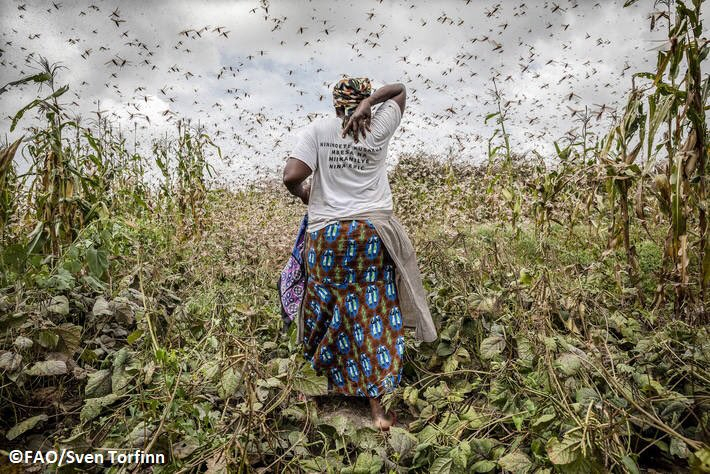The locust crisis has been looming itself in Africa and has reached 10 countries. With the locusts destroying crops in Somalia, Ethiopia and Kenya; it entered Uganda, Tanzania, the Democratic Republic of the Congo and South Sudan. Swarms of locusts have also invaded other countries from eastern Africa to southern Asia as swarms have been forming in Yemen, Saudi Arabia, Iran, Pakistan and India.
World Economic Forum noted that this locust crisis is one among the four global news stories that have been overshadowed by the coronavirus crisis.
Impact of locust crisis
It is told that climate change is the reason for such an outbreak of locusts. It is the worst outbreak in Kenya since 70 years. One swarm occupied an area of sky more than three times the size of New York City, said a piece in Nature.
At a size occupying 100 square kilometres, which is usual, contains between four to eight billion locusts, with the ability to consume the equivalent of what at least 3.5 million people would eat in a day. They can live in 50-70 percent humidity and temperatures between 30-40 degree Celcius.
The UN obsereved such a development as 'extremely alarming'. UN's Food and Agriculture Organization (FAO) warned that if there's a second hatch of the insects, as cropping seasons start, could threaten the food security of 25 million people in the region.

An emergency was declared by provincial Khyber Pakhtunkhwa in nine southern districts on January 29, 2020. The Pakistan government declared an emergency on February 1, 2020.
Pakistan's Agriculture
Around 20 percent of Pakistan's GDP is held by agriculture. The damage by these locusts could cost Pakistan's economic growth to less than two percent by June, according to analysts. The country is also experiencing 12-year high inflation, with the cost of sugar almost doubling and flour prices jumping 15 per cent in 2019.
China, amidst coronavirus crisis decided to send an army of 10,000 ducks to Pakistan to fight these locusts which posed a threat to food security in the country. Keith Cressman, locust forecasting expert for the UN's FAO said that Cyclone Mekunu of 2018 gave conditions of moist sand and vegetation that were ripe for locusts to lay eggs and thrive in the Empty quarter –the desert between Saudi Arabia, Yemen and Oman, reported The Guardian.
When the conditions caused by the cyclone ends, breeding also would come to an end, but the second cyclone struck allowing another generation of breeding, so instead of increasing 400-fold, they increased 8,000-fold, said Cressman.
Biopesticides
Robert Cheke, a zoologist at the Natural Resources Institute in London, which is advising Uganda on locust control told 'biopesticides' can be used to target insects without damaging the surrounding environment.
Cheke's team recommends a fungus called Metarhizium anisopliae, `that kills locusts by growing inside its body. Unlike the chemical spray the fungus is specific to the insect targets rather than killing anything that it hits, said Cheke to Nature. However, it would take between 7 to 14 days for the fungus to grow and kill the pest.









